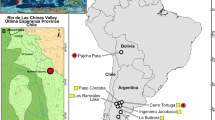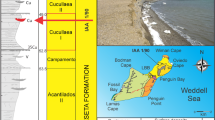Abstract
The putative stem mammal taxon Tikitherium copei was erected based on a single tooth, identified as an upper molar, from the Upper Triassic Tiki Formation of India. Originally thought to be Carnian in age, this taxon was regarded as the oldest mammaliaform in the fossil record. We show that this tooth actually represents the last upper premolar (P4) of a Neogene crocidurine soricid insectivore (order Lipotyphla).


Similar content being viewed by others
Data availability
The modern crocidurine specimens have been accessioned into a recognized public collection (MNHN-ZM and ZIN), where they are available for study. Virtual models of the specimens MNHN-ZM 1981 − 331 and ZIN 102775 are available in MorphoBank project No. 3885 (https://doi.org/10.7934/P3885).
References
Archibald JD, Sues H-D, Averianov AO, King C, Ward DJ, Tsaruk OI, Danilov IG, Rezvyi AS, Veretennikov BG, Khodjaev A (1998) Précis of the Cretaceous paleontology, biostratigraphy and sedimentology at Dzharakuduk (Turonian?-Santonian), Kyzylkum Desert, Uzbekistan. Bull N M Mus Nat Hist Sci 14:21–28.
Averianov AO, Lopatin AV, Krasnolutskii SA, Ivantsov SV (2010) New docodontans from the Middle Jurassic of Siberia and reanalysis of Docodonta interrelationships. Proc Zool Inst Russ Acad Sci 314:121–148. https://doi.org/10.31610/trudyzin/2010.314.2.121
Averianov AO, Lopatin AV, Leshchinskiy SV (2023) New interpretation of dentition in Early Cretaceous docodontan Sibirotherium based on micro–computed tomography. J Mam Evol 30:811–817. https://doi.org/10.1007/s10914-023-09682-4
Averianov AO, Martin T, Lopatin AV, Skutschas PP, Vitenko DD, Schellhorn R, Kolosov PN (2024) Docodontans from the Lower Cretaceous of Yakutia, Russia: new insights into diversity, morphology, and phylogeny of Docodonta. Cret Res:105836. https://doi.org/10.1016/j.cretres.2024.105836
Bhat MS, Ray S, Datta PM (2021) New cynodonts (Therapsida, Eucynodontia) from the Late Triassic of India and their significances. J Paleont 95:376–393. https://doi.org/10.1017/jpa.2020.95
Butler PM (1998) Fossil history of shrews in Africa. In: Wójcik JM, Wolsan M (eds) Evolution of Shrews. Mammal Research Institute Polish Academy of Sciences, Białowieża, pp 121–132
Chakravorti S, Prasad Sengupta D (2023) The first record of chigutisaurid amphibian from the Late Triassic Tiki Formation and the probable Carnian pluvial episode in central India. PeerJ 11:e14865. https://doi.org/10.7717/peerj.14865
Datta PM (2005) Earliest mammal with transversely expanded upper molar from the Late Triassic (Carnian) Tiki Formation, South Rewa Gondwana Basin, India. J Vert Paleont 25:200–207. https://doi.org/10.1671/0272-4634
Datta PM, Ray S (2006) Earliest lizard from the Late Triassic (Carnian) of India. J Vert Paleont 26:795–800. https://doi.org/10.1671/0272-4634(2006)26[795:ELFTLT]2.0.CO;2
Datta PM, Das DP, Luo Z-X (2004) A Late Triassic dromatheriid (Synapsida: Cynodontia) from India. Ann Carnegie Mus 73:12–24. https://doi.org/10.5962/p.215151
Flynn LJ, Jacobs LL, Kimura Y, Taylor LH, Tomida Y (2020) Siwalik fossil Soricidae: a calibration point for the molecular phylogeny of Suncus. Paludicola 12:247–258.
Goloboff PA, Catalano SA (2016) TNT version 1.5, including a full implementation of phylogenetic morphometrics. Cladistics 32:221–238. https://doi.org/10.1111/cla.12160
Hopson JA (1994) Synapsid evolution and the radiation of non-eutherian mammals. In: Prothero DR, Schoch RM (eds) Major Features of Vertebrate Evolution. Short Courses in Paleontology. Paleontological Society, Knoxville, Tennessee, pp 190–219.
Hutchinson MN, Skinner A, Lee MSY (2012) Tikiguania and the antiquity of squamate reptiles (lizards and snakes). Biol Let 8:665–669. https://doi.org/10.1098/rsbl.2011.1216
Ji Q, Luo Z-X, Yuan C-X, Tabrum AR (2006) A swimming mammaliaform from the Middle Jurassic and ecomorphological diversification of early mammals. Science 311:1123–1127. https://doi.org/10.1126/science.112302
Lopatin AV, Tesakov AS (2004) The fossil shrew Cretasorex arkhangelskyi Nessov et Gureev, 1981 from Uzbekistan - the systematic position among Soricidae, taxonomic status and geological age. Rus J Theriol 3:5–8. https://doi.org/10.15298/rusjtheriol.03.1.02
Luo Z-X (2007) Transformation and diversification in early mammal evolution. Nature 450:1011–1019. https://doi.org/10.1038/nature06277
Luo Z-X, Martin T (2007) Analysis of molar structure and phylogeny of docodont genera. Bull Carnegie Mus Nat Hist 39:27–47. https://doi.org/10.2992/0145-9058(2007)39[27:AOMSAP]2.0.CO;2
Luo Z-X, Kielan-Jaworowska Z, Cifelli RL (2002) In quest for a phylogeny of Mesozoic mammals. Acta Palaeont Pol 47:1–78
Maheswari HK, Kumaran KPN (1979) Upper Triassic Sporae Dispersae from the Tiki Formation 1: Miospores from the Son River Section between Tharipathar and Ghiar, South Rewa Gondwana Basin. Palaeontogr, Abt B: Palaeobot 71:1–126
Martin T (2018) Mesozoic mammals - early mammalian diversity and ecomorphological adaptations. In: Zachos FE, Asher RJ (eds) Mammalian Evolution, Diversity and Systematics. De Gruyter, Berlin, Boston, pp 199–299
Meng Q-J, Ji Q, Zhang Y-G, Liu D, Grossnickle DM, Luo Z-X (2015) An arboreal docodont from the Jurassic and mammaliaform ecological diversification. Science 347:764–768. https://doi.org/10.1126/science.1260879
Meredith RW, Janečka JE, Gatesy J, Ryder OA, Fisher CA, Teeling EC, Goodbla A, Eizirik E, Simão TLL, Stadler T, Rabosky DL, Honeycutt RL, Flynn JJ, Ingram CM, Steiner C, Williams TL, Robinson TJ, Burk-Herrick A, Westerman M, Ayoub NA, Springer MS, Murphy WJ (2011) Impacts of the Cretaceous terrestrial revolution and KPg extinction on mammal diversification. Science 334:521–524. https://doi.org/10.1126/science.1211028
Nesov LA, Gureev AA (1981) The find of a jaw of the most ancient shrew in the Upper Cretaceous of the Kizylkum Desert. Doklady A N SSSR 257:1002–1004 [In Russian]
Panciroli E, Benson RBJ, Luo Z-X (2019) The mandible and dentition of Borealestes serendipitus (Docodonta) from the Middle Jurassic of Skye, Scotland. J Vert Paleont 39:e1621884. https://doi.org/10.1080/02724634.2019.1621884
Panciroli E, Benson RBJ, Fernandez V, Butler RJ, Fraser NC, Luo Z-X, Walsh SL (2021) New species of mammaliaform and the cranium of Borealestes (Mammaliformes: Docodonta) from the Middle Jurassic of the British Isles. Zool J Linn Soc 192:1323–1362. https://doi.org/10.1093/zoolinnean/zlaa144
Ray S (2015) A new Late Triassic traversodontid cynodont (Therapsida, Eucynodontia) from India. J Vert Paleont 35:e930472. https://doi.org/10.1080/02724634.2014.930472
Rohlf FJ (2007) tpsDig2, version 2.31. http://life.bio.sunysb.edu/morph/index.html (accessed January 2023)
Voyta LL, Abramov AV, Lavrenchenko LA, Nicolas V, Petrova EA, Kryuchkova LY (2022) Dental polymorphisms in Crocidura (Soricomorpha: Soricidae) and evolutionary diversification of crocidurine shrew dentition. Zool J Linn Soc 196:1069–1093. https://doi.org/10.1093/zoolinnean/zlab103
Wible JR, Rougier GW, Novacek MJ, McKenna MC, Dashzeveg D (1995) A mammalian petrosal from the Early Cretaceous of Mongolia: implications for the evolution of the ear region and mammaliamorph relationships. Am Mus Novit 3149:1–19
Acknowledgements
We thank two anonymous reviewers for reading the paper and providing useful suggestions. We are grateful to Dr. Violaine Nicolas (MNHN, Paris) and Dr. Alexey Abramov (ZIN, Saint Petersburg) for providing access to the Suncus specimens. This work was supported by the “Taxon” Core Facility Centre of ZIN.
Funding
This work was supported by the Russian Science Foundation (project 19–14–00020–P) and the Zoological Institute, Russian Academy of Sciences (project 122031100282–2).
Author information
Authors and Affiliations
Contributions
AA designed the research and acquired funding, composed the data matrix on Docodonta, made phylogenetic analyses, and prepared Fig. 2. AA and LV wrote the main manuscript text. LV composed the data matrix on Soricidae and prepared Fig. 1.
Corresponding author
Ethics declarations
Competing interests
The authors declare no competing interests.
Additional information
Publisher’s Note
Springer Nature remains neutral with regard to jurisdictional claims in published maps and institutional affiliations.
Electronic supplementary material
Below is the link to the electronic supplementary material.
Online Resource 1:
Docodonta character-taxon matrix
Online Resource 2:
Crocidurine character-taxon matrix
Rights and permissions
Springer Nature or its licensor (e.g. a society or other partner) holds exclusive rights to this article under a publishing agreement with the author(s) or other rightsholder(s); author self-archiving of the accepted manuscript version of this article is solely governed by the terms of such publishing agreement and applicable law.
About this article
Cite this article
Averianov, A.O., Voyta, L.L. Putative Triassic stem mammal Tikitherium copei is a Neogene shrew. J Mammal Evol 31, 10 (2024). https://doi.org/10.1007/s10914-024-09703-w
Accepted:
Published:
DOI: https://doi.org/10.1007/s10914-024-09703-w




